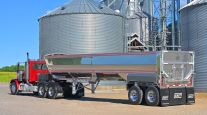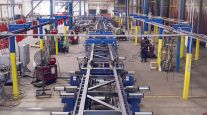Intelligent Trailer Technology Advances
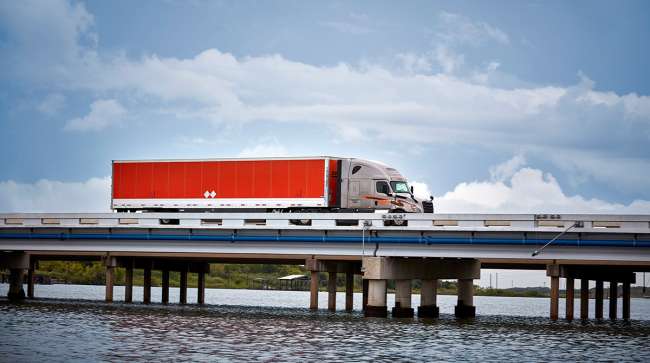
[Stay on top of transportation news: Get TTNews in your inbox.]
Imagine that a half-loaded trailer sitting in a yard for five days could tell you that its right front outside tire had low air pressure, its rear upper roadside marker light is out and the consignee’s free storage term has just expired.
For a trailer equipped with telematics technology capable of powering itself untethered to a tractor, such a scenario is not only possible, but doable.
But just how much trailer technology a fleet adopts depends on the company’s own business needs and strategies.

Degeneffe
Schneider, for one, has deployed trailer monitoring systems primarily to capture trailer location and cargo status, which is key information for managing trailer utilization and driver productivity, said Mike Degeneffe, the fleet’s vice president of solution delivery.
“If the trailer moves in a yard, we’d like to know about it,” Degeneffe said. “Because the thing is, in these large yards, it can take a driver quite a while to find the trailer. So, if they’re assigned to pick up a trailer, they can look up the trailer numbers in the system and they can see an aerial shot of where that trailer is and then they can say, ‘Take me there,’ and it navigates them to the trailers.”
Schneider, based in Green Bay, Wis., ranks No. 5 on the Transport Topics Top 100 list of the largest for-hire carriers in North America.
It operates a fleet of 60,000 trailers across three divisions — intermodal, transportation management and truckload services. Schneider’s dry van trailers and intermodal containers are equipped with Omnitracs TT210 tracking units, which the company is phasing out in favor of the SkyBitz Smart Trailer system.
“The data we get from our trailer solutions is a key input to our overall network planning software,” Degeneffe said. “We use advanced analytics and decision science technology to optimize our trailer utilization and trailer pool management. The drivers are more productive because we can help them locate their assigned trailers with pinpoint accuracy.”

Azmoudeh
Many carriers such as Schneider have been diversifying by operating several different divisions in response to rapidly changing economic conditions, said Siamak Azmoudeh, vice president of product line management and business development at SkyBitz.
Azmoudeh said the technology supplier developed its next-generation SkyHub wireless platform to fit in a variety of configurations.
The platform was designed to take full advantage of long-range Bluetooth technology and 4G LTE, as well as 5G wireless technology once it becomes more widely available in the next few years. This will allow SkyHub’s application programming interface to communicate with the fleet’s in-cab telematics system in the truck. No longer will fleets have to depend solely on physical connectivity between the devices in order for drivers to know with certainty which trailer to pick up, he said.
Azmoudeh believes this development could eventually enable fleets to remotely perform some aspects of pre-trip inspections of trailers so that when they are assigned to drivers, fleets would have a higher level of confidence that they are ready for operation. However, drivers would still need to complete their pre-trip inspections since not all trailer components can be remotely monitored, he added.
“Simple things like that, I think, are going to have a big impact in the way people run their business on a day-to-day basis,” he said.
Cargo Tracking
Technology companies are providing the capability to track not only the trailer, but also the cargo inside.

Montgomery
PowerFleet, for example, offers Bluetooth cargo tags — a kind of next-gen RFID technology — that could provide shippers and consignees much greater visibility into the movement of their freight, said Craig Montgomery, the company’s senior vice president of global branding, U.S. marketing and business development.
However, he also stresses the importance of letting transportation firms take up new smart trailer technology at their own pace — a crawl, walk, run strategy.
“[Technology providers] have to give fleets the ability to modularly, and at their own pace, instrument their trailers with the level of intelligence that they believe is needed, or that the customer asks for, to service the market,” Montgomery said. “And that has to be able to be deployed either in an OEM off-the-line fashion or an aftermarket fashion. And you need to give fleets the flexibility to choose. The problem the industry has had in the past is that they’ve shoved a one-size-fits-all down to the fleet. And that’s not what you want to do.”
Azmoudeh of SkyBitz agrees. He made the case that SkyBitz’s work in improving cargo sensing capability will greatly improve efficiency for many fleets, particularly when it comes to areas such as claim management insurance.
“Just the fact that we have volumetric data now where you can see whether the trailer is partially full, how much floor space is available … is going to change the way they operate, and it could add to their profitability,” Azmoudeh added. “Even our truckload carrier customers know when you have a better understanding of what the [freight] pattern is, how much load you’re carrying, [that capability] is going to change the way [they operate].”
Managing Trailer Data
As companies collect more and more data on their trailer fleets, they need to find ways to effectively utilize that information.
Technology provider Spireon enables customers to view their trailers on its FleetLocate online portal or utilize Spireon’s API to download data from their trailers into their own transportation management systems.
Fleets also have a third option to parse their data. Reza Hemmati, Spireon’s vice president of product management, said the company’s partnership with Snowflake, a cloud data platform provider, offers fleets the ability to query the same data that Spireon displays on the FleetLocate web portal.
With Snowflake, they can use basic business analytics skills to create queries that can produce actionable reports and alerts without having to download the data into their own systems, Hemmati said.
“It doesn’t require a deep knowledge of data architecture — that’s the beauty of Snowflake,” he added. “It’s really a limitless opportunity for our customers once we start telling them that you have access to the same database we use. ... You can go back and access all of your historical data and combine it with your truck telematics data or combine it with your dispatch data. That’s powerful.”
Increasingly, fleets are discovering that access to raw data from trailer monitoring systems can, with the right tools, be used to create all manner of alerts, reports and other actionable material.
One such company is Lachine, Quebec-based Vitesse Transport, which operates a fleet of 320 trailers including dry vans, refrigerated units and flatbeds.
Domenic Santini, chief technology officer for Vitesse, said several years ago he used a business intelligence application to convert trailer data into visual reports that graphically show the number of dwell time incidences and the loss of potential revenue to the company.
“Visually, I was able to show them, ‘You can see here where the trailer hasn’t moved for six days,’ ” Santini said. “That’s six days of no revenue on this asset. So it was more of a visual that ended up convincing them, ‘Hey, this is really the direction we should be going into.’ ”
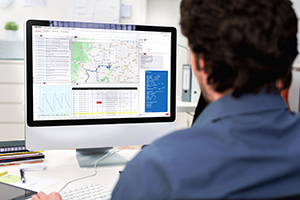
The cloud-based Orbcomm platform provides transportation company customers with a single, unified view of all their assets. (Orbcomm)
Santini and his reports eventually convinced Vitesse’s management to standardize the company’s trailer tracking with one vendor — Orbcomm — utilizing its GT 1100 units for dry vans and its PT 6000 devices for the company’s newest refrigerated trailers. Vitesse recently bought 10 new trailers specifically to haul vaccines for a pharmaceutical company in accordance with Health Canada’s environmental control of drug transportation guidelines.
Santini said the two-way command feature to monitor and control temperatures that’s available with Orbcomm’s equipment is absolutely critical to meeting those guidelines, which require the refrigeration units to report cargo temperatures every five minutes.
To provide that feature, the PT 6000 integrates directly with transport refrigeration units from both Thermo King and Carrier Transicold, said Chris Corlee, director of sales engineering for Orbcomm.
“We can receive those notifications in real time when there is a fault code from the unit,” Corlee said. “And we have the ability to clear those faults remotely. So you’re not asking the driver to take that truck off the road and take it to a shop. A lot of times you can clear those alarms and resolve the issue remotely without having to enter the shipment or delay delivery.”
Sensor Integration
Fleets and technology vendors are connecting their trailer monitoring systems with an expanding array of other onboard sensors.
Through a pilot program, Penske Truck Leasing and Penske Logistics are evaluating the Road Ready SmartBridge Integrator, which allows the Truck-Lite Road Ready trailer telematics system to integrate wirelessly with tire pressure and wheel-end temperature systems.
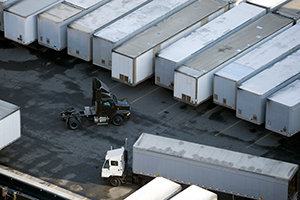
Trailers at a terminal. (kevinjeon00/Getty Images)
Launched in 2017, Road Ready offers fleets an overview of a trailer’s environment, both inside and out, using a variety of customizable wireless sensors. Long-life batteries allow Road Ready hardware to gather reports on untethered trailers, and the user interface displays trailer location and condition in real time on any device with an internet connection.
Since March 2018, Road Ready has provided master control units and cargo sensors to Penske Truck Leasing and Penske Logistics.
“We have the pilot program trailers dispatched in multiple parts of the United States and Canada,” said Paul Rosa, senior vice president of procurement and planning at Penske Truck Leasing.
The coronavirus pandemic has slowed progress on the pilot program, and the data uploads have encountered some disruptions in areas where there wasn’t 4G LTE coverage or the Wi-Fi was down, but Rosa said the sensor integration is proceeding as planned.
“The actual SmartBridge itself is taking in a lot of sensor options, which has been great,” he said. “They are working diligently with so many different component providers to ensure that the data flowing is going to flow fluidly and easily.”
Standardization
While trailer monitoring has advanced far beyond basic location tracking, there is still room for growth, both in terms of technology development and market adoption.
According to Paul Menig, executive director of the Transportation Safety Equipment Institute, as recently as last year only 1.5 million of the 6 million trailers in operation in North America, or 23%, were equipped with a telematics system to track their location and status.
Menig said he believes wider adoption will require the trailer business to pursue standardization efforts similar to those that saw the adoption of the SAE J-1939 industry standards and the OBD-II diagnostic port protocol for trucks.

Natural gas and propane join electric power as alternatives to diesel. Host Seth Clevenger talks with Chad Lindholm of Clean Energy and Stuart Weidie of Alliance Autogas. Hear a snippet, above, and get the full program by going to RoadSigns.TTNews.com.
Menig also serves on task forces of American Trucking Associations’ Technology & Maintenance Council that are developing voluntary best practices for industry standards and communication protocols for intelligent trailer technologies.
Various trailer component providers such as liftgate manufacturers, tire pressure and inflation system providers and refrigeration unit makers “all have some idea of what it is they want to do to make a trailer smarter,” Menig said.
He added that all of these constituents and intelligent trailer technology providers would have to agree on standardization in three key areas — power connections, wireless communication interfaces and wired communication connections.
At the same time, the trailer technology market will have to account for both existing trailers as well as new ones that will be built to different specifications.
“There are new safety requirements coming. There are new electrical things coming as we move to more electrically powered items. All that has to be taken into effect to what we’re going to do for the future,” Menig said.
Even with the availability of smart trailer components such as trailer location tracking devices, remote cargo temperature monitoring and tire pressure management systems, Charles Willmott, Principal CEO of WillGo Transportation Consulting, said he believes such components do not yet constitute true trailer intelligence.
Willmott said he firmly believes in the importance of trailer intelligence for improving trailer utilization.
He also sees trailer intelligence as an important step toward autonomous trucks, platooning, truck electrification and advanced freight logistics.
But Willmott cited three primary barriers to the adoption of trailer technology: power management, difficulties in retrofitting legacy equipment efficiently and economically, and sustainability of two-way communications in a tethered and untethered status.
“[Trailers] have a braking system and an electric harness skeleton that is vintage Thomas Alva Edison,” Willmott added. “It’s just not appropriate for the kind of sensing and information data gathering and predictive analytics that’s necessary for the next generation of freight-carrying.”
Want more news? Listen to today's daily briefing:
Subscribe: Apple Podcasts | Spotify | Amazon Alexa | Google Assistant | More


